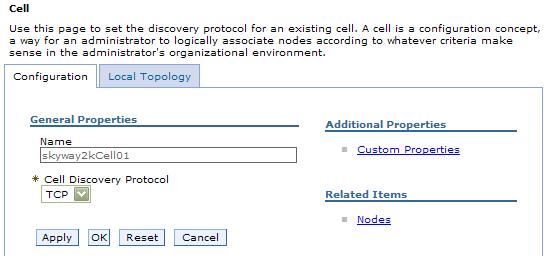Operating Systems: i5/OS
Configure cells
This topic describes how to change the cell protocol information, define custom properties for the cell, and add additional nodes.
Before you can configure cells, install the WebSphere Application Server Network Deployment product.
Overview
When you create a deployment manager profile, a cell is created. A cell provides a way to group one or more nodes of your Network Deployment product. You define the nodes that make up a cell, according to the specific criteria that make sense in your organizational environment. You probably do not need to configure the cell again.
Administrative configuration data is stored in XML files. A cell retains master configuration files for each server in every node in the cell. Each node and server also have their own local configuration files. Changes to a local node or to a server configuration file are temporary, if the server belongs to the cell. While in effect, local changes override cell configurations. Changes to the master server and master node configuration files made at the cell level replace any temporary changes made at the node when the cell configuration documents are synchronized to the nodes. Synchronization occurs at designated events, such as when a server starts.
Procedure
- Access the settings page for a cell. Click...
System Administration | Cell

...from the navigation tree of the administrative console.
- If the protocol that the cell uses to retrieve information from a network is not appropriate for your system, select the appropriate protocol. By default, a cell uses TCP. If you want the cell to use User Datagram Protocol, select UDP from the list for Cell Discovery Protocol on the settings page for the cell. It is unlikely that you need to change the cell protocol configuration from TCP.
- Click Custom Properties and define any name-value pairs that your deployment manager needs.
- When you install the WebSphere Application Server Network Deployment product, a node may have been added to the cell. You can add additional nodes on the Node page. Click Nodes to access the Node page, which you use to manage nodes.
WebSphere Application Server on other platforms has support for IPv4 and IPv6. However, the i5/OS platform supports IPv4 only. When you add a node to a cell, the format in which you specify the host name is based on the version of IP that the node is using.
Results
Depending on which steps you performed, you changed the cell protocol
information, defined custom properties for the cell, and added additional
nodes.
What to do next
You can continue to administer your Network Deployment product by
doing such tasks as managing nodes, node agents, and node groups.
IP version considerations for cells
Delete the IPV4 or the IPV6 multicast port
Cell settings
Related concepts
Node
Related tasks
Configure deployment managers
Manage nodes
Manage node agents
Related Reference
Ports collection
